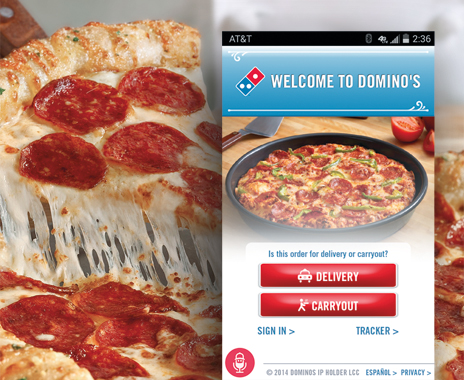More than two decades ago, Pizza Hut sold its first pizza online—reportedly the first thing ever sold on the Internet. Ever since, the nation’s pizza chains have been leading the way in online sales innovation. And this year, that innovation is expected to continue as pizza brands fight off a stiff competitive field.
In the last two years, the industry saw new online ordering tools from some of the biggest quick-serve pizza players. For example, in 2013, Pizza Hut’s online sales surpassed the $1 billion mark, helped in part by the brand’s game-changing Xbox 360 ordering app, which reportedly generated more than $1 million in sales in its first four months. And in October, competitor Domino’s Pizza, another leader in online ordering, debuted its voice-ordering system, allowing customers to order on the mobile app using their voice rather than their fingers. The voice-activated system is named Dom and works like Apple’s Siri.
Domino’s spokesman Chris Brandon says the new technology is the latest chapter in the pizza brand’s revival story. For the last five years or so, the company has been on an honesty campaign, acknowledging its faults in past pizza recipes and rolling out new menu items.
“It was about fixing the pizza, expanding the menu, making sure we had the best pizza on the market, and making sure we expanded to having great things beyond pizza,” Brandon says. “That took us through the most recent chapter. And at some point, you have to figure out what’s going to take you through the next one. And we think it’s technology.”
Already, online ordering makes up 45 percent of all Domino’s sales in the U.S. Dom should speed up ordering for regular customers, Brandon says, because instead of scrolling through menu items, they can simply tell him what they want.
Five years ago, Domino’s executives never expected to market the technology platform, instead focusing their attention on menu improvements, Brandon says. But to stay competitive, it was where the brand needed to go. “A lot of the sentiment lately is that Domino’s is becoming a tech company that also sells pizza,” Brandon says.
The need for tech innovation is spreading into the fast-casual pizza segment, too. Uncle Maddio’s Pizza Joint rolled out its new online ordering system at the end of 2014. The cloud-based system required no new hardware acquisitions and allowed the 25-unit chain to integrate online ordering with its loyalty and POS systems. Scott Goodrich, senior vice president of operations, says the system reduced liability by moving encrypted customer credit card information to the cloud, not storing it in-house.
Goodrich says the move to online ordering was a must for the fast-casual brand. With a longstanding tradition of delivery and carryout, pizza shops are uniquely positioned—and somewhat painted into a corner—to take up online ordering.
“There’s an association with pizza that’s hard to break away from,” Goodrich says. “When folks see you don’t have online ordering, they may not try it. They’ll move on to next thing that’s more convenient.”
Instead of creating a new mobile app, Uncle Maddio’s opted for website ordering. People’s phones are cluttered with apps, Goodrich says, and mobile restaurant apps can sometimes look disjointed.
With an integrated POS and online ordering system, Uncle Maddio’s restaurants can set limits on online orders. So if a store is slammed at noon, for example, it could allow only 15 online orders. A customer might find that time slot full and order his pizza for an earlier or later time slot, helping the kitchen better manage its volume and build business outside traditional hours.
“The idea is not to slow down the amount of online orders that come in at any time,” Goodrich says. “It’s just to manage it.”
But there’s no question that small regional chains face an uphill battle versus big chains with big technology budgets. For Wisconsin-based Toppers Pizza, online ordering was just another tool in the company’s aggressive battling against the nation’s biggest pizza chains.
“Competing with the strongest chains, it’s kind of the price to play,” says Scott Gittrich, founder and CEO of the 60-unit chain. “When you’re competing with the smaller chains and mom-and-pop [restaurants], it’s a massive wedge between those stores and us.”
And the cost of staying ahead can be vast. Toppers will roll out a new ordering system this spring, only to replace it in 2016 with a newer, customized system. There will be a mobile app, but the first priority is creating an ordering site that’s responsive to various mobile devices. “In our industry, it’s like we’re a regional bookstore and we’re looking at Amazon.com,” Gittrich says. “We’re looking at incredible functionality on the big chain’s websites. And our intention is to have a site that’s not only as functional as theirs, but to be better. There’s no end to where you can invest.”
Online ordering is rapidly growing in popularity with Toppers customers. And Gittrich predicts it could make up 90 percent of sales within 10 years.
“It changes a store,” he says. “It is something else to be in a store that does 50 percent of its business online. It’s quieter. The phones aren’t ringing. There are no customers in the lobby, and the orders just keep coming in.”






